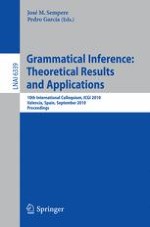2010 | Buch
Grammatical Inference: Theoretical Results and Applications
10th International Colloquium, ICGI 2010, Valencia, Spain, September 13-16, 2010. Proceedings
herausgegeben von: José M. Sempere, Pedro García
Verlag: Springer Berlin Heidelberg
Buchreihe : Lecture Notes in Computer Science
